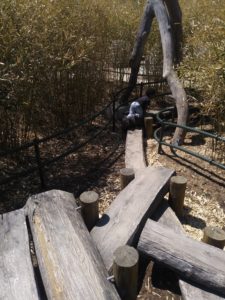We have much more to do and your continued support is needed now more than ever.
What is a Naturalized Outdoor Learning Environment?

The Early Childhood Health Outdoors (ECHO) program was created out of necessity; a necessity for all young children to have daily access to quality outdoor learning, creating a lifelong affinity for wildlife starting with our youngest children. By providing opportunities for kids to get their hands dirty and experience natural elements, like foliage, rocks, insects, and more, we’re shaping the way our kids view nature and the world around them.
In the midst of busy school schedules, sports, and other extracurricular activities, it’s often hard to fit in a trek to a park or natural area. The lure of technology and other factors that all too often trump outdoor play as part of children’s every day routine are creating new trends linked to increased childhood obesity rates, vitamin D deficiency, and a generation of tuned-out and stressed-out kids. This is where ECHO comes in to counteract these trends by providing every child with quality naturalized outdoor learning environments….but what exactly does that mean?
The ECHO team was asked this question a few weeks ago and it left us stumped. Not because we didn’t know how to convey what a “naturalized outdoor learning environment” is – but because it means so much that we took pause when beginning to unravel the complexities of these spaces.
Just as children learn in an indoor classroom by engaging with age-appropriate materials arranged in a manner conducive to learning, the outdoors offer itself as an unconfined classroom without walls or a ceiling. In essence, a naturalized outdoor learning environment is a natural playground or ‘classroom’ with elements that provide exposure to wildlife and the ever-changing dynamics of nature – bringing us back to those fundamental opportunities for kids to explore the world around them.

Imagine a traditional playground – you’re probably thinking of hard plastic and rubber, right? Modern playgrounds can be uninspiring, sterile and have little to offer for child development. Conversely, a naturalized outdoor learning environment may have stumps and logs to walk across, patches of dirt to touch and feel, a stick fort that offers privacy and thoughtfulness, or smooth stones to stack and count. There’s limitless possibilities with natural elements that encourage unstructured play and imagination. Rather than being told how to play, these natural learning environments allow kids to explore, discover, and interact with the space in a new way every time they visit.

Natural outdoor learning environments are so much more than just a natural playground. These spaces are designed and created with intentionally selected natural elements that spark curiosity and discovery while offering age-appropriate and safe play. The spaces evolve and grow over time, constantly changing and engaging kid’s senses while ensuring no two days are ever the same. Moreover, kids who are exposed to natural elements engage in social interactions more often, develop critical thinking and problem solving, and have a greater interest in nature.
Through daily interactions with wildlife and the natural world, we’re not only sparking children’s play, but supporting healthy physical and cognitive development. Through the ECHO program, we’re empowering exploration and curiosity while creating a love for the animals and nature that thrive among us – fostering the next generation of conservation stewards. For more information about the ECHO program, and how you can build your own naturalized outdoor learning environment, visit https://www.nwf.org/ECHO and follow us on Facebook and Twitter.
Learn More!





















